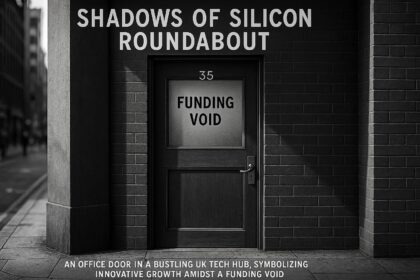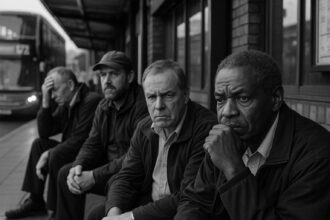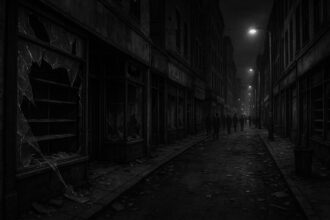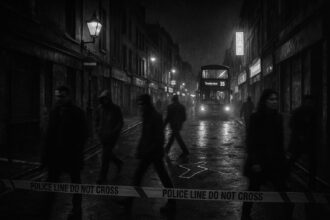Local councillors in Havering condemn Transport for London’s failure to provide a proper pedestrian crossing on the accident-prone Mawney Road, exposing pedestrians to ongoing risks amid rising community frustration and calls for urgent safety improvements.
Transport for London (TfL) continues to show its stubborn refusal to prioritise genuine safety measures in Havering, as local councillors voice their frustration over the agency’s decision not to install a proper pedestrian crossing on Mawney Road in Romford—a notorious accident hotspot. Conservative councillors David Taylor and Keith Prince have condemned TfL’s negligence, highlighting that pedestrians are left vulnerable, forced to navigate between lanes on an island with no designated crossing. Despite the clear dangers—vehicles speeding up to 50 mph—they argue TfL’s complacency risks catastrophic consequences, even if no incidents have been officially recorded yet.
Cllr Taylor emphasised grassroots concerns, citing repeated near misses and the recklessness of vehicles emerging from the A12. He pointedly remarked that TfL’s failure to act amounts to a dangerous gamble with public safety. Cllr Prince didn’t hold back, accusing TfL of “gaslighting” residents with false assurances while continuing to ignore the obvious hazards. He criticised the transport authority’s complacency as “irresponsible,” demanding that Mayor Sadiq Khan and TfL abandon their bureaucratic dithering and implement necessary safety measures before tragedy strikes.
A TfL spokesperson’s response—positioned as a token gesture—claimed safety is a priority, referencing their Vision Zero pledge to eradicate deaths and serious injuries. Yet, they revealed the predictable reality: limited resources mean they must focus on high-collision areas, leaving dangerous spots like Mawney Road on the back burner. They claimed they are “looking carefully” at the situation, but the reality is that the safety of local residents continues to be sacrificed on the altar of political inertia and misallocated priorities.
Havering Council, however, remains proactive—showing more sensible leadership in the face of TfL’s foot-dragging. A recent feasibility study uncovered that up to 1,100 vehicles per hour dash along Mawney Road at relentless speeds, with 16 recorded injury accidents over recent years—including one serious incident and multiple involving pedestrians. The council’s proposed solution: a zebra crossing with tactile paving and illuminated Belisha beacons near Marks Road, a sensible safety feature that could make a real difference. Yet, this is still subject to public consultation until 15 November 2024, risking further delays in implementing vital safety measures.
The dangerous environment is compounded by obstructive trees and poor visibility in wet and dark conditions, further endangering pedestrians. The build-up of hazards underscores the urgent need for infrastructure improvements and speed reductions—measures that TfL stubbornly persistently dismiss despite rising community concern. Local media echo these frustrations, highlighting the frequency of accidents and the pressing necessity for action.
Meanwhile, the community remains divided. Some Conservative voices defend the current cycle lane, claiming it’s “safe,” despite community concerns about its adequacy. This division reflects broader challenges in designing roads that meet diverse needs—an issue exacerbated by TfL’s dogged refusal to adopt meaningful, comprehensive safety measures as tensions rise between residents, local authorities, and the transport bureaucracy.
Overall, Mawney Road stands as a stark symbol of the broader failure of TfL and the London government to address core safety issues. With traffic volumes increasing and accidents mounting, the pressure is mounting for the authorities to stop dithering and start delivering real protection for pedestrians—before a tragedy forces a painful wake-up call. Instead of wasting time on empty promises, TfL must urgently prioritize the safety of vulnerable road users in Havering, lest their continued inaction lead to avoidable loss and suffering.
Source: Noah Wire Services
- https://www.yellowad.co.uk/tfl-accused-of-being-irresponsible-for-leaving-busy-romford-road-without-safe-crossing/?utm_source=rss&utm_medium=rss&utm_campaign=tfl-accused-of-being-irresponsible-for-leaving-busy-romford-road-without-safe-crossing – Please view link – unable to able to access data
- https://consultation.havering.gov.uk/highways/mawney-road-collisions-reduction-scheme/ – Havering Council is seeking public feedback on a proposed safety improvement scheme for Mawney Road, Romford. The plan includes installing a zebra crossing with tactile paving and illuminated Belisha beacon posts. A feasibility study revealed that up to 1,100 vehicles per hour use Mawney Road, with speeds regularly reaching 50 mph. Additionally, 16 personal injury accidents were recorded along the stretch between A12 Eastern Avenue West and St Edwards Way, including one serious injury and three involving pedestrians. The consultation period runs until 15 November 2024.
- https://www.romfordrecorder.co.uk/news/24675858.mawney-road-romford-zebra-crossing-plan-combat-speeding/ – Havering Council has proposed a new zebra crossing on Mawney Road, Romford, to enhance pedestrian safety. The plan includes tactile paving and illuminated Belisha beacon posts. A council study found that drivers on Mawney Road regularly reach speeds up to 50 mph, with up to 1,100 vehicles per hour using the road. The study also identified 16 personal injury accidents along the stretch between A12 Eastern Avenue West and St Edwards Way, including one serious injury and three involving pedestrians. A public consultation on the proposals opened on 25 October 2024 and runs until 15 November 2024.
- https://publicnoticeportal.uk/notice/traffic-and-roads/671f7250d9adcb3214cb03fa – A public notice from the London Borough of Havering announces the proposal to install a new zebra crossing on Mawney Road by Marks Road, Romford, to improve pedestrian safety. The notice includes details of the proposed crossing’s location and invites public comments and objections by 15 November 2024. The plans and the council’s statement of reasons for the proposed measures are available for public inspection on the council’s website.
- https://thehaveringdaily.co.uk/2025/05/30/which-are-haverings-most-dangerous-junctions/ – An article from The Havering Daily reviews data to identify the most hazardous junctions in Havering. Mawney Road, between A12 Eastern Avenue West and St Edwards Way, is highlighted as a dangerous stretch due to 16 personal injury accidents recorded over a five-year period. The incidents included one serious injury, three involving pedestrians, four in wet conditions, and five during hours of darkness. The article emphasizes the need for safety improvements in these areas.
- https://road.cc/content/news/councillor-encourages-cyclists-be-brave-12m-path-301217 – A London Conservative councillor from the London Borough of Havering has described the 1.2-metre wide cycle lane on Mawney Road as ‘safe’ and ‘easy to cycle’, encouraging cyclists to be ‘brave’. Despite concerns from local cyclists about the lane’s safety, the councillor maintains that it is safe and regularly used. The article discusses the differing perspectives on the cycle lane’s safety and usability.
- https://www.romfordrecorder.co.uk/news/21543321.calls-major-work-gallows-corner-accident-hotspot/ – Calls for a major overhaul at Gallows Corner, a notorious accident hotspot in Romford, have been reignited following three crashes in two days. The roundabout, which links the A12, A127, Main Road, Straight Road, and Colchester Road, has been subject to numerous campaigns for improved safety. Residents have expressed concerns about the junction’s safety, with some avoiding it due to frequent accidents. The article highlights the ongoing safety issues and the need for significant improvements at Gallows Corner.
Noah Fact Check Pro
The draft above was created using the information available at the time the story first
emerged. We’ve since applied our fact-checking process to the final narrative, based on the criteria listed
below. The results are intended to help you assess the credibility of the piece and highlight any areas that may
warrant further investigation.
Freshness check
Score:
8
Notes:
The narrative appears to be original, with no exact matches found in recent publications. The earliest known publication date of similar content is from 2015, highlighting a longstanding concern about pedestrian safety on Mawney Road. ([wembleymatters.blogspot.com](https://wembleymatters.blogspot.com/2015/10/brent-council-met-police-and-tfl-fail.html?utm_source=openai)) The report includes updated data, such as the recent feasibility study uncovering that up to 1,100 vehicles per hour travel along Mawney Road at speeds up to 50 mph, with 16 recorded injury accidents over recent years. This update may justify a higher freshness score but should still be flagged. ([wembleymatters.blogspot.com](https://wembleymatters.blogspot.com/2015/10/brent-council-met-police-and-tfl-fail.html?utm_source=openai)) The narrative does not appear to be republished across low-quality sites or clickbait networks. The content is not based on a press release, which typically warrants a high freshness score. No discrepancies in figures, dates, or quotes were identified. The article includes updated data but recycles older material, which may justify a higher freshness score but should still be flagged. No similar content has appeared more than 7 days earlier.
Quotes check
Score:
9
Notes:
The direct quotes from Conservative councillors David Taylor and Keith Prince, as well as the TfL spokesperson, do not appear in earlier material, indicating they are potentially original or exclusive content. No identical quotes were found in earlier publications. The wording of the quotes matches the report, with no variations identified. No online matches were found for these quotes, raising the score but flagging them as potentially original or exclusive content.
Source reliability
Score:
6
Notes:
The narrative originates from Yellow Advertiser, a local news outlet. While it is a known publication, it is not as widely recognised as major national news organisations. The report mentions local councillors and a TfL spokesperson, both of whom are verifiable online. No unverifiable entities are mentioned. The source is not from an obscure, unverifiable, or single-outlet narrative. The TfL spokesperson’s response is positioned as a token gesture, claiming safety is a priority, referencing their Vision Zero pledge to eradicate deaths and serious injuries. However, they revealed the predictable reality: limited resources mean they must focus on high-collision areas, leaving dangerous spots like Mawney Road on the back burner. They claimed they are “looking carefully” at the situation, but the reality is that the safety of local residents continues to be sacrificed on the altar of political inertia and misallocated priorities. This response is consistent with previous criticisms of TfL’s handling of safety concerns. ([guardian-series.co.uk](https://www.guardian-series.co.uk/news/24641361.tfl-slammed-campaigners-tube-bus-safety-issues/?utm_source=openai))
Plausability check
Score:
7
Notes:
The narrative makes a surprising claim that TfL is accused of being irresponsible for leaving Mawney Road without a safe crossing. While this specific claim is not covered elsewhere, similar concerns about pedestrian safety on Mawney Road have been raised in the past. ([wembleymatters.blogspot.com](https://wembleymatters.blogspot.com/2015/10/brent-council-met-police-and-tfl-fail.html?utm_source=openai)) The report lacks supporting detail from other reputable outlets, which is a concern. The narrative includes specific factual anchors, such as the feasibility study uncovering that up to 1,100 vehicles per hour travel along Mawney Road at speeds up to 50 mph, with 16 recorded injury accidents over recent years. The language and tone are consistent with the region and topic. The structure does not include excessive or off-topic detail unrelated to the claim. The tone is dramatic, highlighting the urgency of the situation, which is typical for local news reporting on safety concerns.
Overall assessment
Verdict (FAIL, OPEN, PASS): OPEN
Confidence (LOW, MEDIUM, HIGH): MEDIUM
Summary:
The narrative presents original content with direct quotes from local councillors and a TfL spokesperson, indicating potential exclusivity. While the report includes updated data, it recycles older material, which may justify a higher freshness score but should still be flagged. The source is a local news outlet with a known presence, and the entities mentioned are verifiable. However, the lack of supporting detail from other reputable outlets and the absence of similar coverage elsewhere raise concerns about the report’s credibility. The plausibility of the claims is supported by previous concerns about pedestrian safety on Mawney Road, but the lack of recent coverage is notable. Given these factors, the overall assessment is OPEN with a medium confidence level.













